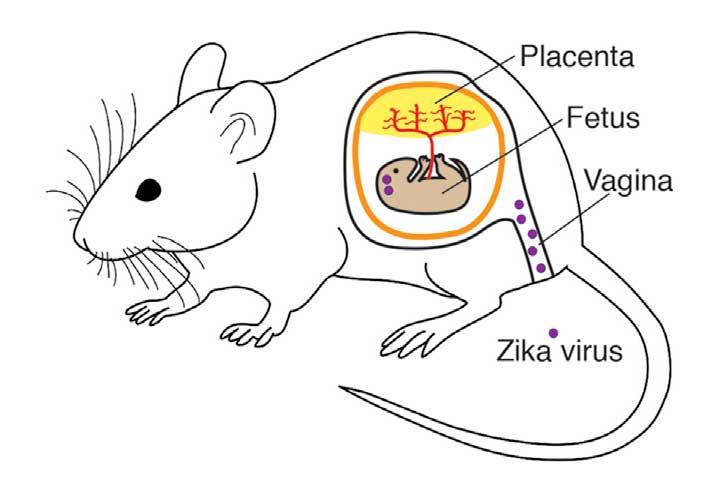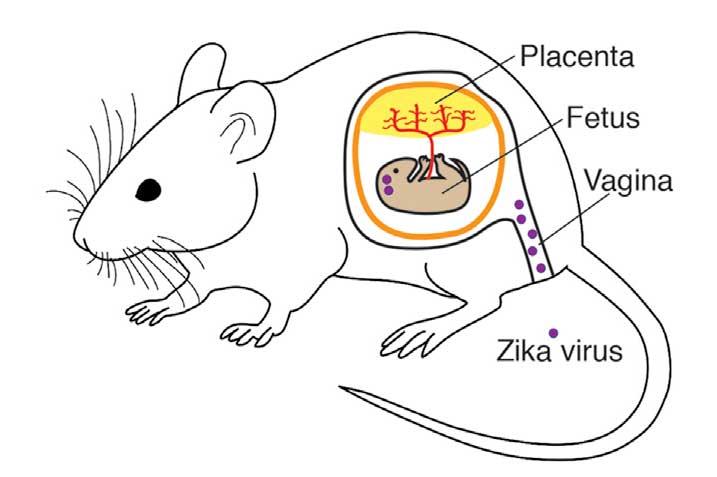
The Zika virus, commonly transmitted through a bite from an infected mosquito, is also capable of leaping from person to person through sexual transmission. However, the mechanisms Zika uses to invade the body from the genitals, and the havoc it may wreak from there, are unclear. To better understand the process, a group of researchers has developed the first mouse model of a vaginal Zika infection, described in a Cell paper publishing August 25.
"The Zika virus appears to have a niche within the vagina," says senior author Akiko Iwasaki, an immunobiologist at Yale University. "We see from our model that it's a place where the virus can replicate for an extended period of time, and in pregnant mice, vaginal infection can lead to brain infection of the fetus and growth restriction."
Iwasaki's lab has been studying viral infections of the genital mucosa for years, primarily using the herpes simplex virus. When reports began to surface of the Zika virus being sexually transmitted, Iwasaki's interest was piqued. "Using our expertise in genital herpes, we want to understand how the Zika virus behaves when it's transmitted vaginally," she says. "The vaginal mucosa was predicted to be a site for virus replication, but there was no hard evidence, so we wanted to create a mouse model."
Mice normally aren't susceptible to Zika–in other models of infection, the animals must first be genetically engineered to be vulnerable to the virus. But when it came to a vaginal infection, Iwasaki's team discovered that the virus can survive and replicate for several days in the mucosa even in normal mice. "That's the most surprising finding of this study," Iwasaki says.
When the researchers vaginally infected normal, pregnant mice with the Zika virus, they observed slowed development and brain infection in the fetuses. In the mice genetically engineered to be vulnerable, the virus replicated uncontrollably in the fetus and caused spontaneous abortions. Iwasaki and her colleagues plan to continue researching vaginal infection with the Zika virus in both types of animals. "Studying these things in parallel allows us to see the spectrum of disease," she explains.
The research team is working on a number of critical questions with the new model, including what route the virus takes from the vaginal mucosa to infect the fetus. "The fact that a sexually transmitted virus can end up in the brain of the fetus is worrisome," says Iwasaki. "We're investigating this rigorously." The researchers are also examining new ways of blocking Zika virus entry through the vaginal tract. The study gives clues for blocking the virus within the genitals through the interferon pathway.
"We're cautious about any conclusions regarding human transmission at this point, but the vagina may be a place, in addition to the testes, where the Zika virus can replicate for an extended period of time," says Iwasaki. "We need to be careful about advising the public about sexual exposure with infected women. This study adds a piece to the puzzle in terms of the vagina as a site for virus replication–vaginal secretions may be a reservoir for the Zika virus in humans, but this requires more investigation."
###
This study was supported by the Howard Hughes Medical Institute and the National Institutes of Health.
Cell, Yockey et al.: "Vaginal exposure to Zika virus during pregnancy leads to fetal brain infection in wild type mice" http://www.cell.com/cell/fulltext/S0092-8674(16)31053-4
Cell (@CellCellPress), the flagship journal of Cell Press, is a bimonthly journal that publishes findings of unusual significance in any area of experimental biology, including but not limited to cell biology, molecular biology, neuroscience, immunology, virology and microbiology, cancer, human genetics, systems biology, signaling, and disease mechanisms and therapeutics. Visit: http://www.cell.com/cell. To receive Cell Press media alerts, contact [email protected]
Media Contact
Joseph Caputo
[email protected]
617-397-2802
@CellPressNews
http://www.cellpress.com





